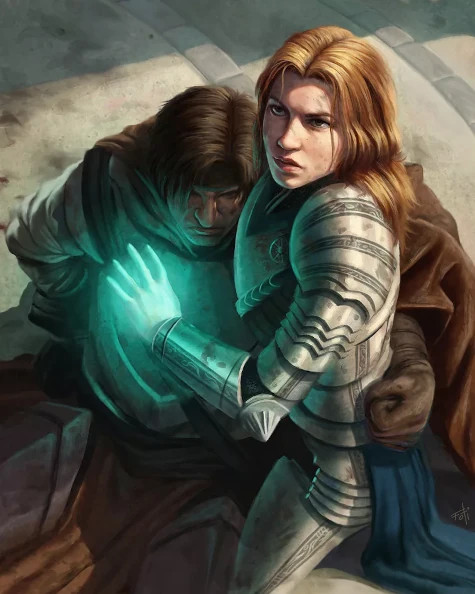Earlier in the week I posted some rules for Gritty Healing & Survival in 5e. These work for group looking for that kind of long-term resource management and play. However, it leaves a bit of a gap when it comes to healing spells and magic. In fact, most gritty mechanics suffer from the problem of setting up a system for persistent injuries, then introduce magic that lets you skip past it. Also, it suffers from the problem of turning the cleric into the heal-bot for a party, making sit out of the action during encounters to heal everyone later. So having some way to align the leaning mechanic with the core idea of recovery as a central design principle is important. Without it, you end up with the same effect as healing overnight but force the healing PC to burn all their resources and sit most encounters out.
I expect this option to be controversial. It flies in the face of the conventional expectation of drinking a wheelbarrow full of healing potions, and it makes the pacing and of games much more volatile.

Skin In the Game
As it is, healing is just something that falls out of the sky. Be it divine intervention, alchemy, or some other magic. It costs the recipient nothing and can continue indefinitely if the party has resources. With these rules, healing spells cost the recipient something, limiting how much they can benefit from spells and abilities. That has the effect of involving the receiving player in the decision and managing healing as a resource as well. Lore wise the premise is simple, the body can only take so much and flesh has it’s limits. It is a staple of many narratives to have the healer provide some limited help, then back away with a “I’ve done all I can, the rest is up to them”. This rules brings that lore into play.
The Rule
A recipient must spend one Hit Die to gain the benefit of a healing spell, potion, or ability. Meaning they must agree to being healed and mark off one of their own Hit Die to gain the benefit. A healing spell, potion, or ability may still be used on a willing target with no Hit Die to spend or who does not wish to spend a HD. This includes targets who are unconscious. In cases where no HD is spent by the target, the healing works but only does 1 point.
Notes on Specific Spells and Abilities
- Healing over multiple rounds, such as with Healing Spirit, costs the recipient 1 HD per round.
- Goodberry: Recipients can only benefit from the effects of one goodberry per long rest. It counts as food to avoid starvation but does not qualify as Good Food for the recovery rules in Gritty Healing & Survival.
- Lay On Hands: The recipient must spend a Hit Die to gain the benefit of multiple points of healing. Otherwise, they can receive one point of healing per action without spending a Hit Die.
- Tiny Hut: Works as normal except it does not provide a magical barrier against damage or intrusion. For purposes of Shelter it counts as having proper equipment and cancels out environmental conditions as per the spell description.
- Lesser Restoration: No longer automatically cures any disease. Instead, it gives the target an immediate saving throw against the disease at advantage.
- Spells that removes conditions behaves normally in terms of condition removal but rules above take precedence if there are additional results.
- Temporary HP are unaffected by these rules.
- Fighters can use Second Wind without spending Hit Die, but they are considered temporary hit points that last until the end of the next Long Rest.
Mixing and Matching
While I’m proposing this system for the Gritty Healing & Survival Rules I published earlier in the week, it can be used with a number of systems. There are other gritty or slow healing systems in use this can either be used with directly or with slight modification. Half HD healing and only healing half max hp on long rest, fixed HP per rest, or any number of other systems are all skipped past with normal healing. These rules could work well with any of those systems to free up the healing PC to participate in the encounter and keep wounds meaningful. In a few weeks I’ll publish a simpler system for tracking wounds this can work with as well.
Alternative Tracking
The core goal here is to limit healing so it doesn’t overturn any long term healing rules, and doesn’t relegate healing classes to heal-bots. Using the Hit Die mechanic is just a way to track and bound the amount of healing being done. If you are not a fan of the Hit Die mechanics you could simply choose another method. Proficiency bonus times per day, half level, fixed number, or something wild like each successive healing attempt per day is less effective. Any of these approaches could work if you keep the core concept in mind, that bounding healing is critical a gritty or long term healing mechanic.
Conclusion
These rules close a bit loophole in the original Gritty Healing and Survival rules as presented. It further reduces the recovery rate of players but serves two purposes. First it doesn’t create a situation where healing casters are holding onto all their spell slots to heal everyone. While it can be fun to know that you are keeping the party up and running, this frees them up more to participate directly in encounters. Second, it maintains the long-term management aspects by keeping a Hit Die Economy in the campaign timescale. Lastly, it encourages downtime and other activities not focused on the combat encounter.
Now go out there and run some great games.